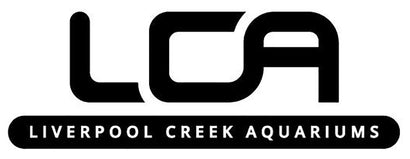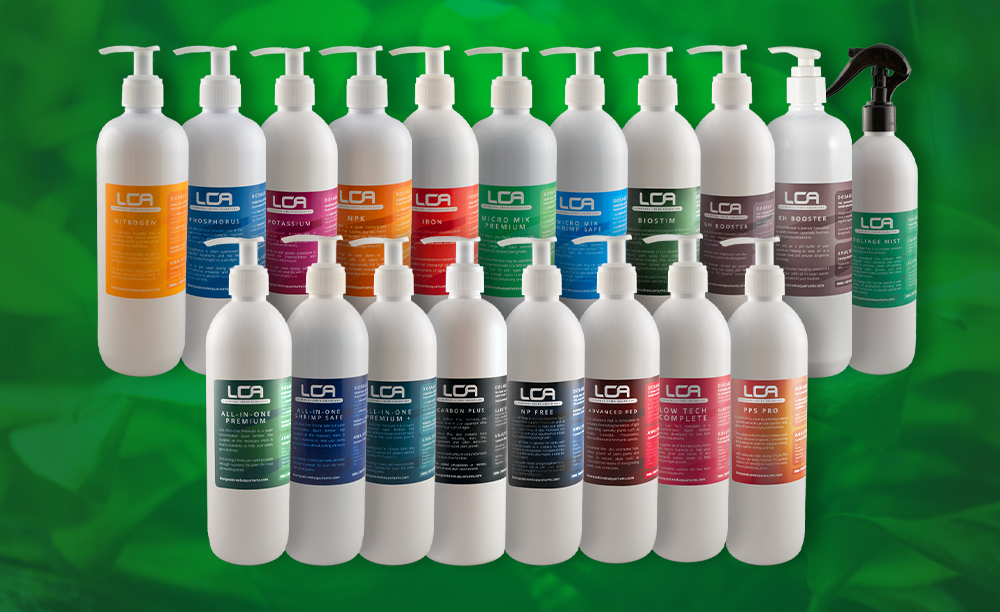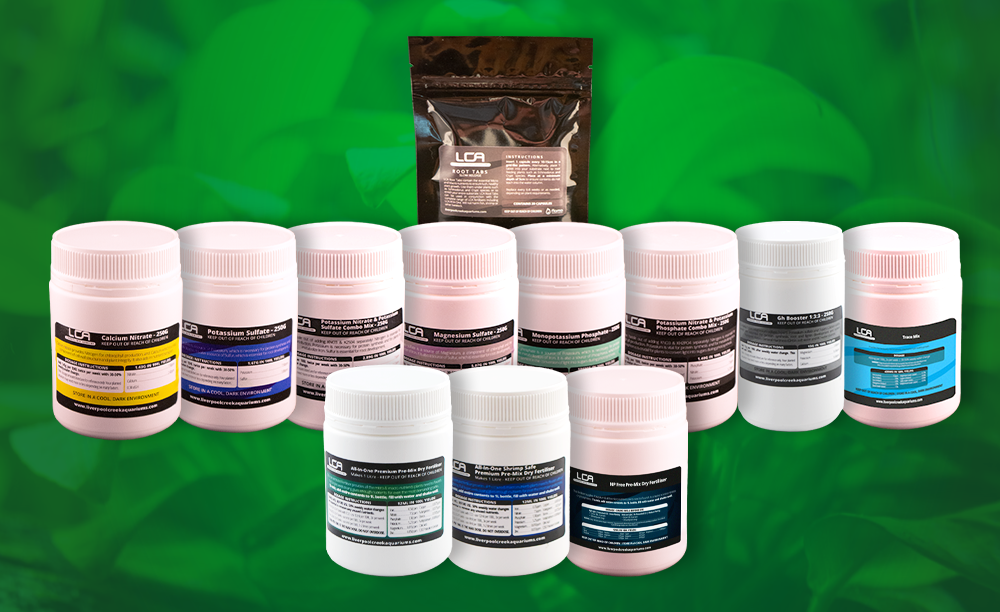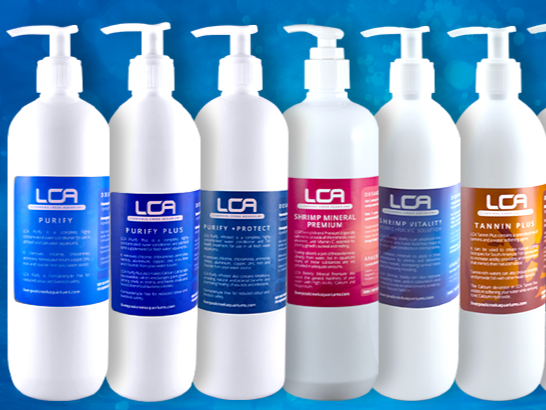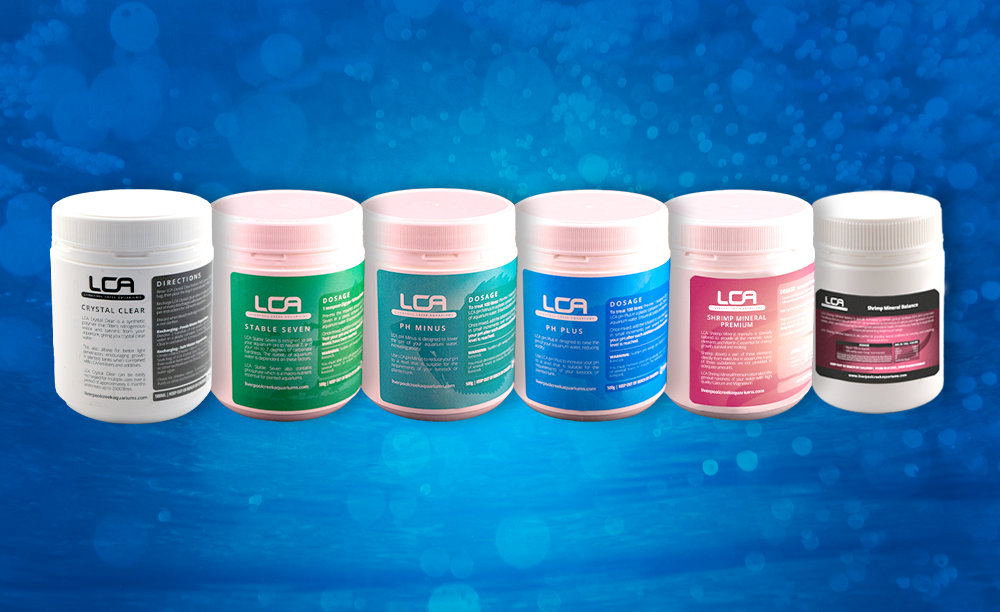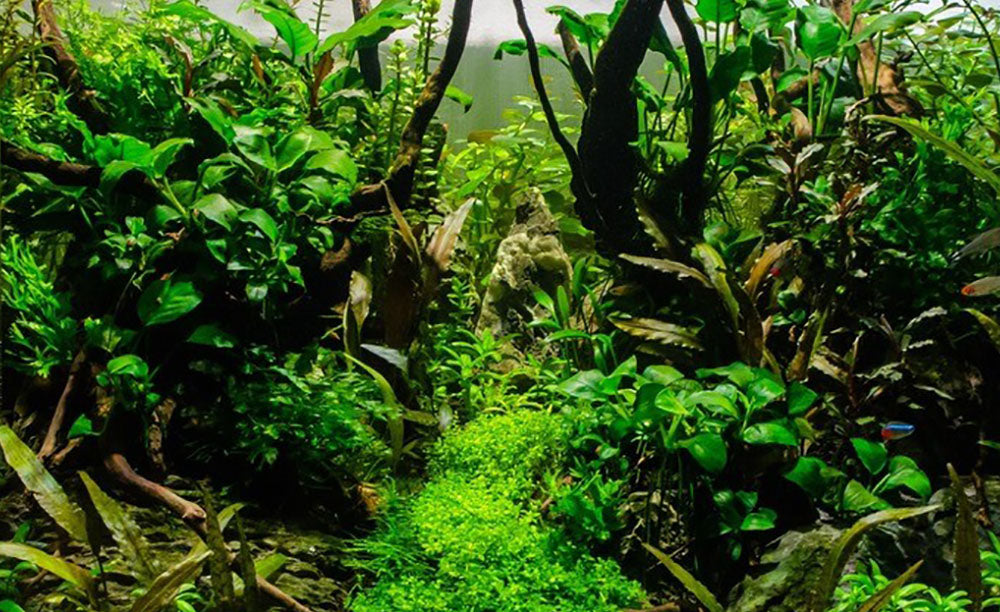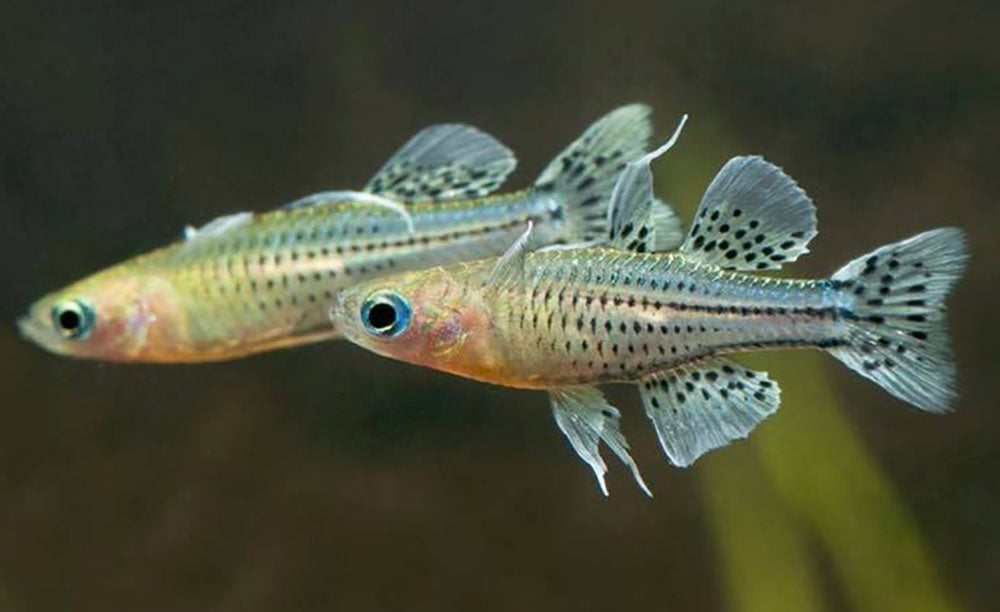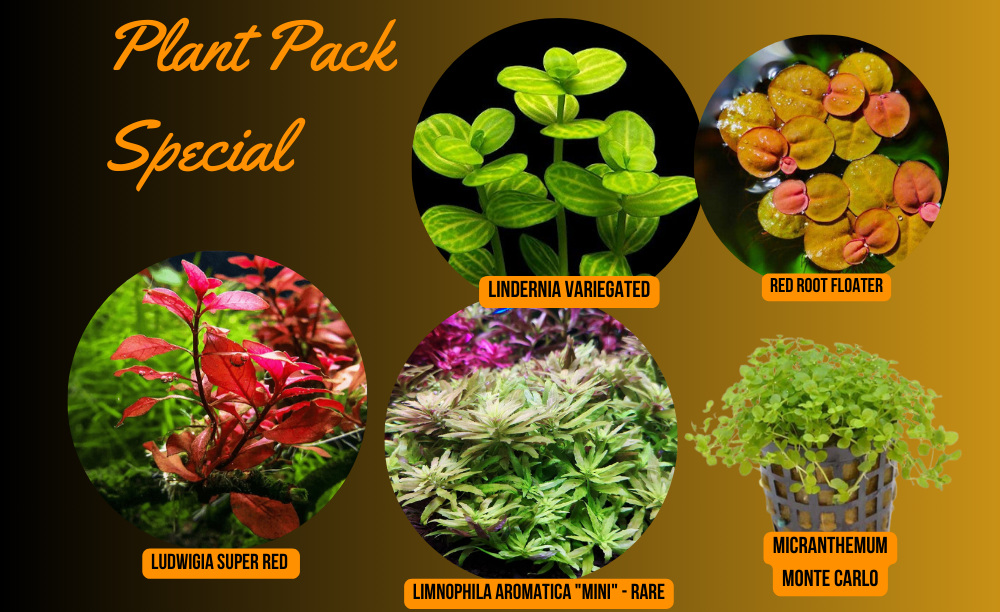Your Cart is Empty
we are now CLOSED FOR OUR ANNUAL BREAK
ANY NEW ORDERS WILL NOT BE SENT UNTIL EARLY JANUARY
***FREE SHIPPING ON ORDERS OVER $200***
we are now CLOSED FOR OUR ANNUAL BREAK
ANY NEW ORDERS WILL NOT BE SENT UNTIL EARLY JANUARY
***FREE SHIPPING ON ORDERS OVER $200***
Store
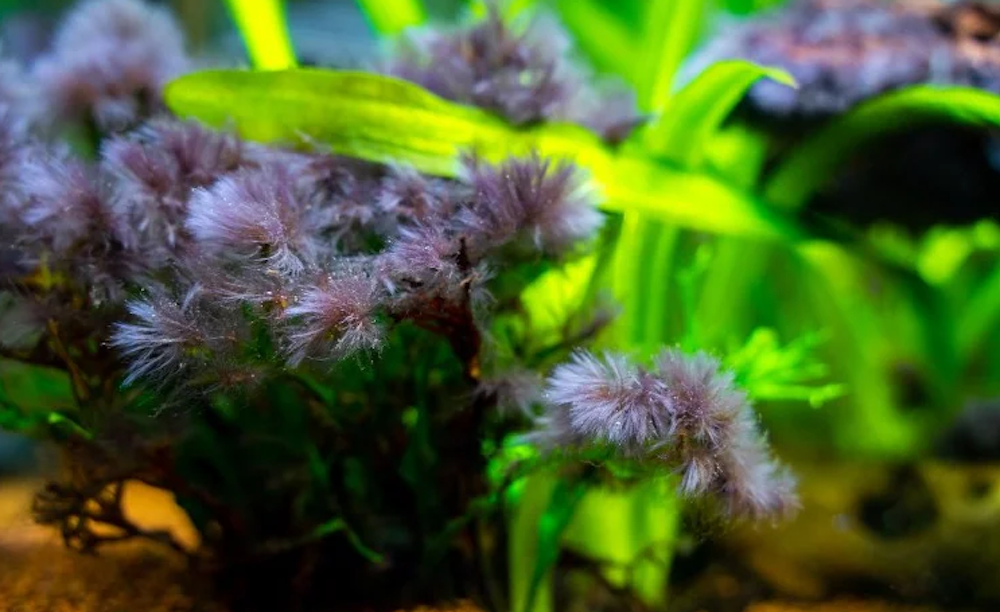
Algae Guide Part 2
10 min read
Algae Types & Their Causes
Brown Algae (Diatoms)
Appearance
Diatoms most commonly appear as small soft clumps of brown or yellowish green particles, in patches or as a stringy brown mass. It is extremely common in new aquariums that are still cycling but can also appear in tanks using a DIY dirted substrate or those with low plant mass.
It can also appear if your filter is unable to provide a sufficient amount of filtration and beneficial bacteria for your bio-load.
Treatment
Most of the time with diatoms, it’s simply a case of waiting for your aquarium to mature. You can siphon or otherwise manually remove visible diatoms but they will quickly reappear. Once your cycle has established, diatoms will rapidly dwindle. For faster results, you can use commercially available products to help speed up the cycling process.
If you’re using a DIY dirted substrate, it might be leeching ammonia into your water column, which can also cause diatoms to appear. Check that you have a sufficient “cap” over the dirted portion of your substrate and increase its depth if not. Try not to disturb your substrate while planting as this will also release ammonia.
As always, increasing the amount of plants in your aquarium or encouraging healthy plant growth is always beneficial, both in reducing algae and for the overall health of your aquarium system.
There are plenty of livestock options that will eat diatoms – snails, shrimp, otocinclus and more. Apart from previous suggestions, if your tank is cycled and can support them, consider adding a crew of algae eaters!
Appearance
Diatoms most commonly appear as small soft clumps of brown or yellowish green particles, in patches or as a stringy brown mass. It is extremely common in new aquariums that are still cycling but can also appear in tanks using a DIY dirted substrate or those with low plant mass.
It can also appear if your filter is unable to provide a sufficient amount of filtration and beneficial bacteria for your bio-load.
Treatment
Most of the time with diatoms, it’s simply a case of waiting for your aquarium to mature. You can siphon or otherwise manually remove visible diatoms but they will quickly reappear. Once your cycle has established, diatoms will rapidly dwindle. For faster results, you can use commercially available products to help speed up the cycling process.
If you’re using a DIY dirted substrate, it might be leeching ammonia into your water column, which can also cause diatoms to appear. Check that you have a sufficient “cap” over the dirted portion of your substrate and increase its depth if not. Try not to disturb your substrate while planting as this will also release ammonia.
As always, increasing the amount of plants in your aquarium or encouraging healthy plant growth is always beneficial, both in reducing algae and for the overall health of your aquarium system.
There are plenty of livestock options that will eat diatoms – snails, shrimp, otocinclus and more. Apart from previous suggestions, if your tank is cycled and can support them, consider adding a crew of algae eaters!
Cladophora
Appearance
Cladophora grows in short, green filaments that are quite tough. It typically attaches very firmly to hardscape in the aquarium, such as wood or stone. It can also grow throughout plants such as moss and carpeting species, creating a tangled mess.
Some hobbyists will purposely keep Cladophora, as it can look appealing when added to hardscape and carefully managed. In fact, marimo moss balls are a type of cladophora and are widely kept in freshwater aquariums.
If not intentionally introduced, cladophora can be caused by slow water circulation, areas receiving no flow and intense light, areas overcrowded by plants or decaying undergrowth. Generally speaking, low flow encourages this algae to form.
Treatment
To treat, first manually remove as much as possible, which can be difficult. For mild cases, you can spot-treat with hydrogen peroxide misting or products such as LCA Carbon Plus or Triple B.
Any old or decaying growth should be pruned or removed. Similarly, overgrown plants should be trimmed and tops replanted to help with flow. If lighting is intense, consider adding more plants to use the light available.
Increasing growth rates of your existing plants is recommended by optimising your pressurised CO2 (if using), and adjusting fertilisation rates if required.
Appearance
Cladophora grows in short, green filaments that are quite tough. It typically attaches very firmly to hardscape in the aquarium, such as wood or stone. It can also grow throughout plants such as moss and carpeting species, creating a tangled mess.
Some hobbyists will purposely keep Cladophora, as it can look appealing when added to hardscape and carefully managed. In fact, marimo moss balls are a type of cladophora and are widely kept in freshwater aquariums.
If not intentionally introduced, cladophora can be caused by slow water circulation, areas receiving no flow and intense light, areas overcrowded by plants or decaying undergrowth. Generally speaking, low flow encourages this algae to form.
Treatment
To treat, first manually remove as much as possible, which can be difficult. For mild cases, you can spot-treat with hydrogen peroxide misting or products such as LCA Carbon Plus or Triple B.
Any old or decaying growth should be pruned or removed. Similarly, overgrown plants should be trimmed and tops replanted to help with flow. If lighting is intense, consider adding more plants to use the light available.
Increasing growth rates of your existing plants is recommended by optimising your pressurised CO2 (if using), and adjusting fertilisation rates if required.
Spirogyra
Appearance
Spirogyra generally grows on plants in dense, medium to long curling threads.
It is usually caused by low CO2, excess organics (especially iron), too much light or poor water circulation.
Treatment
To treat, start by manually removing as much as you can. If using pressurised CO2, reassess the amount you are injecting to see if it is sufficient. Clean your filter to reduce organic waste, and while the spirogyra is present, increase frequency of water changes – weekly if you are not already doing so, 2x per week otherwise.
If your photoperiod is longer than 7 hours or your lighting is particularly intense, reduce your schedule to 6 hours and observe over 2-3 weeks for any changes.
If you are using fertilisers containing Iron, consider adjusting your dosage rate or using a product containing less iron to reduce the levels in your aquarium water.
If circulation is poor, you can add a circulation pump, upgrade to a more powerful filter or trim overgrown plants to allow for better flow. Trimming plants has the added benefit of creating more bushy growth.
Treatment with products such as LCA Carbon Plus or Triple B is effective in weakening or inhibiting algae growth and may be suitable for combating spirogyra as part of a total treatment plan.
Appearance
Spirogyra generally grows on plants in dense, medium to long curling threads.
It is usually caused by low CO2, excess organics (especially iron), too much light or poor water circulation.
Treatment
To treat, start by manually removing as much as you can. If using pressurised CO2, reassess the amount you are injecting to see if it is sufficient. Clean your filter to reduce organic waste, and while the spirogyra is present, increase frequency of water changes – weekly if you are not already doing so, 2x per week otherwise.
If your photoperiod is longer than 7 hours or your lighting is particularly intense, reduce your schedule to 6 hours and observe over 2-3 weeks for any changes.
If you are using fertilisers containing Iron, consider adjusting your dosage rate or using a product containing less iron to reduce the levels in your aquarium water.
If circulation is poor, you can add a circulation pump, upgrade to a more powerful filter or trim overgrown plants to allow for better flow. Trimming plants has the added benefit of creating more bushy growth.
Treatment with products such as LCA Carbon Plus or Triple B is effective in weakening or inhibiting algae growth and may be suitable for combating spirogyra as part of a total treatment plan.

LCA Carbon PLUS will increase carbon level while inhibiting algae growth.
The 'PLUS' is the added trace elements of Iron, Zinc, Magnesium etc, designed to improve plant growth.
There are no added phosphates or nitrates.
Using an efficient bottle pump dispensing system means less mess for you and easier handling
Carbon PLUS ( Shrimp Safe )
Cyanobacteria
Appearance
As the name suggests, Cyanobacteria is not an algae but is in fact a type of photosynthetic bacteria. It appears as an unsightly dark slime, often growing along your substrate and smothering low growing plants. It can also create a distinctive “swampy” smell that will emanate from your aquarium.
Cyanobacteria appears in aquariums that are cycling or unstable, because these systems are low in beneficial bacteria, oxygen and nitrate – plants are not supported but cyanobacteria can use atmospheric nitrogen!
Excess organics and poor flow will also encourage cyanobacteria to appear.
Treatment
First, siphon and otherwise manually remove as much cyanobacteria as possible. Perform a water change to remove excess organics.
If water circulation in your aquarium is poor, consider upgrading your filter or adding a circulation pump to remove the slow flow conditions that cyanobacteria favours. You could also add an air stone or other aeration to aid with this.
There are commercially available antibacterial products that work against cyanobacteria, but they may affect your aquarium’s cycle, as the beneficial bacteria can be weakened or eradicated.
For severe cases of cyanobacteria, a full tank blackout for 5 days may be beneficial. Before blacking out your tank, check your nitrate levels and if below 5ppm increase to 10-15ppm – this will give your plants a chance to gain some mass (yes – even though there is no light).
Appearance
As the name suggests, Cyanobacteria is not an algae but is in fact a type of photosynthetic bacteria. It appears as an unsightly dark slime, often growing along your substrate and smothering low growing plants. It can also create a distinctive “swampy” smell that will emanate from your aquarium.
Cyanobacteria appears in aquariums that are cycling or unstable, because these systems are low in beneficial bacteria, oxygen and nitrate – plants are not supported but cyanobacteria can use atmospheric nitrogen!
Excess organics and poor flow will also encourage cyanobacteria to appear.
Treatment
First, siphon and otherwise manually remove as much cyanobacteria as possible. Perform a water change to remove excess organics.
If water circulation in your aquarium is poor, consider upgrading your filter or adding a circulation pump to remove the slow flow conditions that cyanobacteria favours. You could also add an air stone or other aeration to aid with this.
There are commercially available antibacterial products that work against cyanobacteria, but they may affect your aquarium’s cycle, as the beneficial bacteria can be weakened or eradicated.
For severe cases of cyanobacteria, a full tank blackout for 5 days may be beneficial. Before blacking out your tank, check your nitrate levels and if below 5ppm increase to 10-15ppm – this will give your plants a chance to gain some mass (yes – even though there is no light).
Green Dust Algae (GDA)
Appearance
GDA appears as a fast growing, green film, usually on hardscape and the sides of aquariums. It’s easy to wipe away but will quickly regrow, sometimes overnight. The difference between GDA and Green Spot Algae (GSA) is that GDA forms a thin green film, with no formation of dots like with GSA.
GDA is often develops in tanks with low plant mass and excess organics, in tanks with high light and nutrient rich water, and is encouraged by warmer water temperatures.
It also frequently appears in tanks that are still cycling or in those with insufficient beneficial bacteria.
Treatment
First, you should increase your plant mass so that your nutrients and light are being used. Maintain a regular maintenance schedule of siphoning detritus and changing water on a weekly basis to ensure nutrient and organic levels don’t get too high.
If you’re using pressurised CO2, consider if you are injecting the correct amount into your system.
Less severe cases of GDA can be treated easily with products such as LCA Carbon Plus or Triple B.
In severe cases, starving the GDA of all light sources with a 3-5 day complete blackout can be effective. Keeping nitrate levels low during this period until the GDA dissipates may also be helpful.
Appearance
GDA appears as a fast growing, green film, usually on hardscape and the sides of aquariums. It’s easy to wipe away but will quickly regrow, sometimes overnight. The difference between GDA and Green Spot Algae (GSA) is that GDA forms a thin green film, with no formation of dots like with GSA.
GDA is often develops in tanks with low plant mass and excess organics, in tanks with high light and nutrient rich water, and is encouraged by warmer water temperatures.
It also frequently appears in tanks that are still cycling or in those with insufficient beneficial bacteria.
Treatment
First, you should increase your plant mass so that your nutrients and light are being used. Maintain a regular maintenance schedule of siphoning detritus and changing water on a weekly basis to ensure nutrient and organic levels don’t get too high.
If you’re using pressurised CO2, consider if you are injecting the correct amount into your system.
Less severe cases of GDA can be treated easily with products such as LCA Carbon Plus or Triple B.
In severe cases, starving the GDA of all light sources with a 3-5 day complete blackout can be effective. Keeping nitrate levels low during this period until the GDA dissipates may also be helpful.
Fuzz/Hair/Thread Algae
Appearance
Fuzz, hair and thread algae appear as fine green threads and can be short to very long. These types of algae will grow throughout your tank – on hardscape, plants, tangled through moss – you name it, if conditions are favourable it will grow there.
These algae types are most frequently caused by excessive lighting/photoperiods combined with high levels of organics, ammonia and plants that are damaged, deficient or aging.
Treatment
Any affected growth can be misted with hydrogen peroxide, or the whole tank can be treated easily with products such as LCA Carbon Plus or Triple B. Spot dosing or full tank treatment will help slow the spread of Fuzz, Hair and Thread algae, or weaken the algae so it can be more easily removed by hand or algae eating livestock.
You can also completely remove any affected growth completely to stop the algae from getting a foothold. Healthy, unaffected plant growth can be replanted.
In mild cases of these algae types, it may clear on its own as your aquarium levels stabilise – this is especially true for newly set up aquariums.
For severe cases or those in mature tanks, treatment with LCA Carbon Plus or Triple B should be effective in inhibiting or weakening the algae while you treat the base causes.
Improving the health of your plants by addressing any issues of lighting, fertilisation and CO2 is always recommended – this allows the plants to use the nutrients before the algae can, and stronger plants are more able to defend themselves from algae as well. Adding more plant mass is also a good idea.
You may need to reduce your light period, or raise your light so it is not as intense.
Cleaning your filter, siphoning the substrate of detritus and maintaining a weekly water change schedule in combination with these suggestions will go a long way to defeating these algae types.
Appearance
Fuzz, hair and thread algae appear as fine green threads and can be short to very long. These types of algae will grow throughout your tank – on hardscape, plants, tangled through moss – you name it, if conditions are favourable it will grow there.
These algae types are most frequently caused by excessive lighting/photoperiods combined with high levels of organics, ammonia and plants that are damaged, deficient or aging.
Treatment
Any affected growth can be misted with hydrogen peroxide, or the whole tank can be treated easily with products such as LCA Carbon Plus or Triple B. Spot dosing or full tank treatment will help slow the spread of Fuzz, Hair and Thread algae, or weaken the algae so it can be more easily removed by hand or algae eating livestock.
You can also completely remove any affected growth completely to stop the algae from getting a foothold. Healthy, unaffected plant growth can be replanted.
In mild cases of these algae types, it may clear on its own as your aquarium levels stabilise – this is especially true for newly set up aquariums.
For severe cases or those in mature tanks, treatment with LCA Carbon Plus or Triple B should be effective in inhibiting or weakening the algae while you treat the base causes.
Improving the health of your plants by addressing any issues of lighting, fertilisation and CO2 is always recommended – this allows the plants to use the nutrients before the algae can, and stronger plants are more able to defend themselves from algae as well. Adding more plant mass is also a good idea.
You may need to reduce your light period, or raise your light so it is not as intense.
Cleaning your filter, siphoning the substrate of detritus and maintaining a weekly water change schedule in combination with these suggestions will go a long way to defeating these algae types.
Black Beard Algae (BBA)
Appearance
The scourge of many freshwater aquariums, BBA appears as quite short black or reddish bushy filaments. They start their growth in small bunches, appearing as small black dots typically along leaf edges of slow growing plants, on damaged leaves, occasionally on hardscape and frequently on filter outlets. They are quite tough and attach firmly.
In high-tech tanks, fluctuating CO2 levels are the most likely cause. BBA also appears when there are high amounts of organic waste, when plants are stressed or damaged, or when growth is old and decaying.
BBA also loves high flow and will favour areas that are subjected to it, especially slow growing plants and hardscape.
Treatment
One of the most effective methods in combating BBA is to regularly siphon detritus and other waste from your substrate. Regular substrate cleaning reduces organics significantly and won’t harm your plants as their roots reach lower down for nutrients.
Flow rate should also be examined. If your filter or circulation pump is creating powerful flow, reducing this can greatly hinder BBA from appearing, especially if affected slow growing plants or hardscape are directly in the path of the flow.
If you’re using pressurised CO2, consider if you are injecting the correct amount into your system and adjust it if needed. If your CO2 levels are unstable, BBA will rear its ugly head.
Judicious removal of leaves heavily affected by BBA is recommended so that your plants can focus on healthy growth. Old, stressed or unhealthy growth should be removed – plants will not repair leaves that are damaged, and they will only release more organics as they deteriorate.
Leaves that are only lightly affected can be misted with hydrogen peroxide or the whole tank can be treated easily with products such as LCA Carbon Plus or Triple B. Spot dosing or full tank treatment will help slow the spread of BBA, or weaken the algae so it can be more easily removed by hand or algae eating livestock.
Appearance
The scourge of many freshwater aquariums, BBA appears as quite short black or reddish bushy filaments. They start their growth in small bunches, appearing as small black dots typically along leaf edges of slow growing plants, on damaged leaves, occasionally on hardscape and frequently on filter outlets. They are quite tough and attach firmly.
In high-tech tanks, fluctuating CO2 levels are the most likely cause. BBA also appears when there are high amounts of organic waste, when plants are stressed or damaged, or when growth is old and decaying.
BBA also loves high flow and will favour areas that are subjected to it, especially slow growing plants and hardscape.
Treatment
One of the most effective methods in combating BBA is to regularly siphon detritus and other waste from your substrate. Regular substrate cleaning reduces organics significantly and won’t harm your plants as their roots reach lower down for nutrients.
Flow rate should also be examined. If your filter or circulation pump is creating powerful flow, reducing this can greatly hinder BBA from appearing, especially if affected slow growing plants or hardscape are directly in the path of the flow.
If you’re using pressurised CO2, consider if you are injecting the correct amount into your system and adjust it if needed. If your CO2 levels are unstable, BBA will rear its ugly head.
Judicious removal of leaves heavily affected by BBA is recommended so that your plants can focus on healthy growth. Old, stressed or unhealthy growth should be removed – plants will not repair leaves that are damaged, and they will only release more organics as they deteriorate.
Leaves that are only lightly affected can be misted with hydrogen peroxide or the whole tank can be treated easily with products such as LCA Carbon Plus or Triple B. Spot dosing or full tank treatment will help slow the spread of BBA, or weaken the algae so it can be more easily removed by hand or algae eating livestock.

LCA Triple B ( Black Beard Blast)
This solution is tailored to reduce growth of algae such as Black Beard Algae (BBA) while enhancing lush and healthy foliage in aquarium plants
Full 3x per week dosing for 1 week will see results of black beard algae deteriorate.
Once you see BBA turning orange/white you can stop dosing. If BBA is still at present , please repeat for another week.
Triple B (Black Beard Blast)
Green Spot Algae (GSA)
Appearance
GSA presents first as small green dots on glass, leaves or hardscape that are difficult to scrape off. The dots multiply in number, grow in size and will join nearby spots, forming a hard green scale.
One of the primary causes of GSA is intense light, or lengthy photoperiods, or both combined and some cases a lack of potassium. Slow growing plants such as anubias, when placed under intense light, will almost always attract some amount of GSA.
Stressed, old or decaying plants will also encourage GSA to appear, as they release more unused nutrients than healthy plants – which the GSA then uses to great effect.
As always, excess organics will make matters worse.
Treatment
If your GSA is appearing on plants, remove any unhealthy sections of plants and leaves – they’ll grow more! If you’ve put your slow growing plants in areas that receive a lot of light, adjust their placement to somewhere more shaded.
Clear your aquarium of detritus by siphoning the substrate, and maintain a weekly water change schedule.
If water circulation in your aquarium is poor, consider upgrading your filter or adding a circulation pump to help your nutrients distribute more equally throughout the water column.
Finally, if you’re using pressurised CO2, consider if you are injecting the correct amount into your system and adjust if necessary.
Appearance
GSA presents first as small green dots on glass, leaves or hardscape that are difficult to scrape off. The dots multiply in number, grow in size and will join nearby spots, forming a hard green scale.
One of the primary causes of GSA is intense light, or lengthy photoperiods, or both combined and some cases a lack of potassium. Slow growing plants such as anubias, when placed under intense light, will almost always attract some amount of GSA.
Stressed, old or decaying plants will also encourage GSA to appear, as they release more unused nutrients than healthy plants – which the GSA then uses to great effect.
As always, excess organics will make matters worse.
Treatment
If your GSA is appearing on plants, remove any unhealthy sections of plants and leaves – they’ll grow more! If you’ve put your slow growing plants in areas that receive a lot of light, adjust their placement to somewhere more shaded.
Clear your aquarium of detritus by siphoning the substrate, and maintain a weekly water change schedule.
If water circulation in your aquarium is poor, consider upgrading your filter or adding a circulation pump to help your nutrients distribute more equally throughout the water column.
Finally, if you’re using pressurised CO2, consider if you are injecting the correct amount into your system and adjust if necessary.
Green Water
Appearance
Green water appears as just that – your aquarium water becomes bright green and opaque. It’s not at all harmful to your livestock (in fact, they may appreciate it!) but it does look unsightly and can affect plant growth due to its ability to block light.
It commonly appears in tanks that are still establishing, but will also appear when there is too much light coupled with excess organics from waste and overfeeding. Warm temperatures will also encourage green water in combination with these other factors.
Treatment
If your tank is still in the process of cycling or has only recently been set up, rather than treating, it might simply be a case of waiting for the aquarium system to stabilise.
If the tank is more mature, you may need to reduce your light period, or raise your light so it is not as intense. Maintain a regular maintenance schedule of siphoning detritus and changing water on a weekly basis to ensure nutrient and organic levels don’t get too high.
Performing a 3-5 day complete blackout can be effective in treating green water, especially when combined with use of a UV steriliser. The base causes should also be treated as green water can quickly return.
Appearance
Green water appears as just that – your aquarium water becomes bright green and opaque. It’s not at all harmful to your livestock (in fact, they may appreciate it!) but it does look unsightly and can affect plant growth due to its ability to block light.
It commonly appears in tanks that are still establishing, but will also appear when there is too much light coupled with excess organics from waste and overfeeding. Warm temperatures will also encourage green water in combination with these other factors.
Treatment
If your tank is still in the process of cycling or has only recently been set up, rather than treating, it might simply be a case of waiting for the aquarium system to stabilise.
If the tank is more mature, you may need to reduce your light period, or raise your light so it is not as intense. Maintain a regular maintenance schedule of siphoning detritus and changing water on a weekly basis to ensure nutrient and organic levels don’t get too high.
Performing a 3-5 day complete blackout can be effective in treating green water, especially when combined with use of a UV steriliser. The base causes should also be treated as green water can quickly return.
Staghorn Algae
Appearance
Staghorn algae grows in individual, short branching strands that appear greyish-green in colour. Their branching formation looks a bit like antlers. Staghorn algae usually grows along leaf edges but can appear on hardscape as well.
It’s usually caused by high levels of ammonia and excess organics, and will favour stressed, unhealthy or old plant growth. Low levels of pressurised CO2 will also encourage Staghorn algae to grow.
Treatment
If your tank is still cycling, your ammonia levels will be high - this can’t be avoided without disrupting the process. Wait for your filter to establish its beneficial bacteria and observe the algae to see if it subsides on its own.
If you have an established aquarium, start by cleaning your filter if you haven’t done so recently. Siphon any detritus from your substrate and perform a 50% water change (this should be done weekly).
Plants and leaves can be misted with hydrogen peroxide or the whole tank can be treated easily with products such as LCA Carbon Plus or Triple B. Spot dosing or full tank treatment will help slow the spread of Staghorn, or weaken the algae so it can be more easily removed by hand or algae eating livestock.
You can also completely remove any affected growth completely to stop the algae from getting a foothold. Healthy, unaffected plant growth can be replanted.
If you’re using pressurised CO2, consider if you are injecting the correct amount into your system and adjust if necessary.
Appearance
Staghorn algae grows in individual, short branching strands that appear greyish-green in colour. Their branching formation looks a bit like antlers. Staghorn algae usually grows along leaf edges but can appear on hardscape as well.
It’s usually caused by high levels of ammonia and excess organics, and will favour stressed, unhealthy or old plant growth. Low levels of pressurised CO2 will also encourage Staghorn algae to grow.
Treatment
If your tank is still cycling, your ammonia levels will be high - this can’t be avoided without disrupting the process. Wait for your filter to establish its beneficial bacteria and observe the algae to see if it subsides on its own.
If you have an established aquarium, start by cleaning your filter if you haven’t done so recently. Siphon any detritus from your substrate and perform a 50% water change (this should be done weekly).
Plants and leaves can be misted with hydrogen peroxide or the whole tank can be treated easily with products such as LCA Carbon Plus or Triple B. Spot dosing or full tank treatment will help slow the spread of Staghorn, or weaken the algae so it can be more easily removed by hand or algae eating livestock.
You can also completely remove any affected growth completely to stop the algae from getting a foothold. Healthy, unaffected plant growth can be replanted.
If you’re using pressurised CO2, consider if you are injecting the correct amount into your system and adjust if necessary.
Subscribe
Sign up to get the latest on sales, new releases and more …
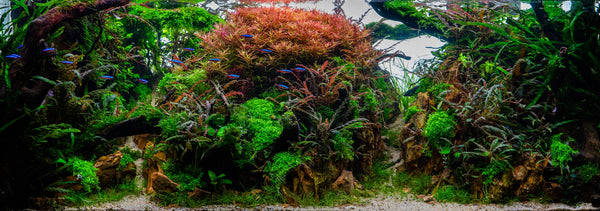
Join Us
Join our Facebook group and benefit from the knowledge of
Australia’s largest community of planted aquarium enthusiasts!
